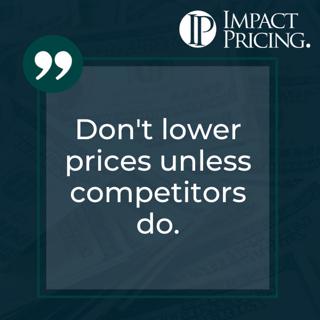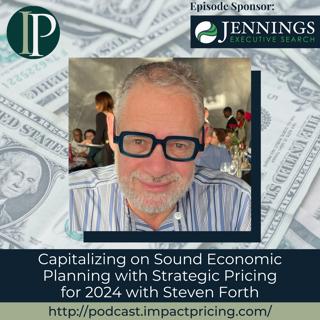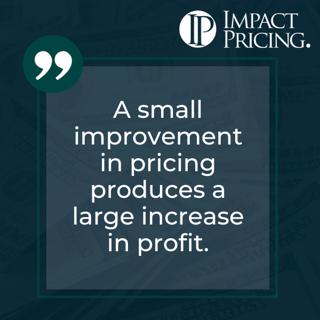
Blogcast: What Comes After Product-Market Fit
This is an Impact Pricing Blog published on November 16, 2023, turned into an audio podcast so you can listen on the go. Read Full Article Here: https://impactpricing.com/blog/what-comes-after-product-market-fit/ If you have any feedback, definitely send it. You can reach us at mark@impactpricing.com. Now, go make an impact. Connect with Mark Stiving: Email: mark@impactpricing.com LinkedIn: https://www.linkedin.com/in/stiving/
29 Joulu 20234min

Pricing Table Topics: Jack of Clubs – Don't Lower Prices
This one is the Jack of Clubs from the Impact Pricing card deck. There's almost never a good reason to lower prices. We've seen that a 1% price increase can lead to a 10% improvement in profitability. Well, the opposite is true too. A 1% price decrease could lead to a 10% decrease in profitability. And that's painful. As a general rule, I would never ever lead a price decrease. I'm not lowering my prices. And the only thing that would ever prompt me to, is if my competitors lowered their price first and I had to keep up with them. I had to match whatever price decrease they put out because they were taking too much of my share. But even if my competitors lowered their price, I wouldn't do an across the board price decrease. Instead, I would look at where is it that my competitors are taking my business. And can I do a price decrease just on that piece of business? Let's start thinking about price segmentation and market segmentation, understanding where that competitor is powerful, is available, and only lower prices in those places where we have to in order to keep our market share. But a great rule is just never lower your prices, unless you have to. We hope you enjoyed this example of Pricing Table Topics. What you just heard was done without a script. If you want to get better at speaking about pricing and value, grab a deck of our playing cards, pick a card, read the saying, talk for one to two minutes about what that card says. You'll become a better speaker and expert. Oh, and you can play games with these cards. If you have any questions or feedback, please email me, mark@impactpricing.com. Now, go make an impact. Connect with Mark Stiving: Email: mark@impactpricing.com LinkedIn: https://www.linkedin.com/in/stiving/
27 Joulu 20232min

A Christmas Pricing Story
There is something about pricing that really gets me excited. Maybe it was my humble beginnings. I'm sure I grew up with more than many people. But from my perspective, we didn't have enough. We needed to make every dollar go as far as it could. At Christmas time, I would get out the Sears catalog and quickly turn to the toy section. I studied every item, in the boy section of course. I would circle, and circle, and circle. I wanted so much. Christmas morning, Santa brought me a few of those toys. My parents made us three kids take turns. I hated having to wait for my brother and sister to take their turns. It was so fun ripping into a package, screaming with excitement. It was the kind of joy we rarely experience as adults. After we kids had opened the Santa packages, it was time for the adults and all of the other gifts. One by one, we would open gifts. It was slow, and tedious, and boring. This is where I got socks and underwear. Completely underappreciated at the time, but several times during this tradition, someone would get a nicer gift from Mom and Dad. Like a sweater, or a jacket. And inevitably, Mom would have a story, "Oh, I found that one at Macy's, and it was just like a more expensive one, but half the price." Or, "Oh, I saved 33% on that using green stamps." Or, "Oh, I shopped at four different stores and finally found a great deal on that one." My mom loved saving money, and she loved telling us about it even more. I didn't know it at the time, but I was learning how important price was to her. Of course, this wasn't just at Christmas. But around the tree on Christmas morning, she had an audience. She had pent up stories she couldn't share until the gift was opened. She was in her element. Maybe my love of pricing started because I wanted to understand my mom better. Who knows? But there are few things I like better than figuring out how people think about price. I am extremely grateful for what mom and dad did for us. They provided so many great memories. I loved Christmas as a child. I loved my mom who left us several years ago. And I still love pricing. This Christmas, I hope you find great deals on all of the gifts. And especially the memories that you give. Merry Christmas and Happy Holidays. Connect with Mark Stiving: Email: mark@impactpricing.com LinkedIn: https://www.linkedin.com/in/stiving/
25 Joulu 20233min

Blogcast: Software Shrinkflation
This is an Impact Pricing Blog published on November 9, 2023, turned into an audio podcast so you can listen on the go. Read Full Article Here: https://impactpricing.com/blog/software-shrinkflation/ If you have any feedback, definitely send it. You can reach us at mark@impactpricing.com. Now, go make an impact. Connect with Mark Stiving: Email: mark@impactpricing.com LinkedIn: https://www.linkedin.com/in/stiving/
22 Joulu 20233min

Pricing Table Topics: Jack of Diamonds – You're Not Charging Enough
This one is the Jack of Diamonds from the Impact Pricing card deck. It's true. If you're winning them all, you're not charging enough. First, you have to believe that every buyer is different. Every buyer has a different willingness to pay. If every time you go bid on someone and you know that they have a different willingness to pay, and yet you always win, that means that most of your buyers, if not all of your buyers, were willing to pay you more. In fact, it's probably a fair assumption that every time you win a deal, you left money on the table. The buyer was probably willing to pay you a little bit more, or a lot more, than what the price was you finally settled on. What that says to me is that if we never ever lose, we're nowhere near that price point that says, Hey, we're losing the right number. So, once again, if you were to raise your price by 1% that has a 10% impact on profitability, potentially, and probably zero impact on sales because you're winning everything already. And even if you lost a couple deals, you're not going to lose 10% of your deals. And so, that's a really smart thing for you to be doing if you're after more profit, which I hope you are. And so, look at your win ratios. Are you winning every deal you go after? And if you are, raise prices. We hope you enjoyed this example of Pricing Table Topics. What you just heard was done without a script. If you want to get better at speaking about pricing and value, grab a deck of our playing cards, pick a card, read the saying, then talk for one to two minutes about what that card says. You'll become a better speaker and expert. And, you can play games. If you have any questions or feedback, please email me, mark@impactpricing.com. Now, go make an impact. Connect with Mark Stiving: Email: mark@impactpricing.com LinkedIn: https://www.linkedin.com/in/stiving/
20 Joulu 20232min

Capitalizing on Sound Economic Planning with Strategic Pricing for 2024 with Steven Forth
Steven Forth is Ibbaka's Co-Founder, CEO, and Partner. Ibbaka is a strategic pricing advisory firm. He was CEO of LeveragePoint Innovations Inc., a SaaS business designed to help companies create and capture value. In this episode, Steven advocates for proactive scenario planning, encouraging businesses to identify critical uncertainties and fortify their pricing strategies for the uncertainties of the future. Why you have to check out today's podcast: Understand the significance of pricing as a strategic element often overlooked in planning, and recognize its pivotal role in post-COVID economic landscapes Acknowledge the shift to a sounder economic period, where capital has a tangible cost, emphasizing the importance of net present value as a cornerstone of planning assumptions Prioritize fixing issues strategically, considering both short-term and long-term plays, and embrace scenario planning for effective pricing strategies in a dynamic environment "I think we are settling into a sounder economic period where capital has a cost, net present value matters, and we need to have that as a planning assumption." - Steven Forth Topics Covered: 01:38 - An observation about pricing being overlooked in strategic planning for 2024 and pricing being just an afterthought 04:20 - The need to strategically approach pricing in the context of the next three years post-COVID and thoughts on the monetization of generative AI 07:24 - Important thoughts on what kind of impact will AI have in businesses in the years ahead in comparison to what blockchain years ago 09:32 - From low interest rates to normal range, the importance of capital costs and net present value as part of planning assumptions. 13:05 - The need to take realistic steps to investments in AI, impact of non-zero interest rates on capital costs, the stabilization of buying behaviors into 2024 and how all these are considered in pricing planning in 2024 18:47 - Prioritizing what needs to be fixed first rather than fixing all at once and risk messing up everything 19:52 - How often should one conduct a pricing strategy 22:25 -Two key things in mind when planning for 2024: first establish baselines and trends, then aligning pricing with the overall strategic goals of the company 27:13 - What it means to have a portfolio point of view when making pricing planning and how to implement a faster cadence to reach your pricing goals 30:09 - Attributing business results to pricing changes and introducing the concept of causal analysis Key Takeaways: "I think we are settling into a sounder economic period where capital has a cost, net present value matters and we need to have that as a planning assumption." - Steven Forth "You can't really do strategic planning if you don't understand where you are and how you got there." - Steven Forth "I would encourage people to at least consider looking at scenario planning where you plan for more than one scenario. You identify critical uncertainties and you plan for each of the critical uncertainties. That approach would make a lot of sense for pricing." - Steven Forth People / Resources Mentioned: Judea Pearl: https://en.wikipedia.org/wiki/Judea_Pearl The Book of Why: The New Science of Cause and Effect: https://www.amazon.com/Book-Why-Science-Cause-Effect/dp/046509760X Connect with Steven Forth: LinkedIn: https://www.linkedin.com/in/stevenforth/ Email: steven@ibbaka.com Connect with Mark Stiving: LinkedIn: https://www.linkedin.com/in/stiving/ Email: mark@impactpricing.com
18 Joulu 202333min

Blogcast: System 1 and System 2 Value
This is an Impact Pricing Blog published on November 2, 2023, turned into an audio podcast so you can listen on the go. Read Full Article Here: https://impactpricing.com/blog/system-1-and-system-2-value/ If you have any feedback, definitely send it. You can reach us at mark@impactpricing.com. Now, go make an impact. Connect with Mark Stiving: Email: mark@impactpricing.com LinkedIn: https://www.linkedin.com/in/stiving/
15 Joulu 20233min

Pricing Table Topics: Jack of Hearts – Improvement in Pricing Produces Increase in Profit
This one is the Jack of Hearts from the Impact Pricing card deck. If you have the ability to raise your prices and you can still sell the same or just slightly fewer products, you are almost guaranteed to make much more profit. There are many studies out there that show a 1% increase in pricing can yield a 10% improvement in profitability. Now, how does that make sense? It makes sense because if you assume for a second that you have 10% gross margin on your product. So, I'm going to throw some numbers at you here. Assume that it costs, you're going to sell something for $100. It costs you $90 to make it. So, you have 10% gross margin and you're making $10 in profit on that product, or on that sale. If you can raise your price 1%, so we go from a 100 to 101, we just raised our profit from 10 to 11. And that's because raising price has zero impact on our costs. Every dollar we make from the price increase goes directly to the bottom line. So, if we went from 100 to 101, we increased price by 1%. We took our profit from 10 to 11. We increased our profit by 10%. Obviously, that 10% number has everything to do with what's the gross margin of your product at the moment, and that's how you could determine. But price increases go straight to the bottom line without impacting or being affected by our costs. And so, therefore, it's often the single most profitable, most powerful, marketing mix variable any company has. We hope you enjoyed this example of Pricing Table Topics. What you just heard was done without a script. If you want to get better at speaking about pricing and value, grab a deck of our cards, pick a card, read the saying, then talk for one to two minutes about what that card says. You'll become a better speaker and expert. And, you can play games. If you have any questions or feedback, please email me, mark@impactpricing.com. Now, go make an impact. Connect with Mark Stiving: Email: mark@impactpricing.com LinkedIn: https://www.linkedin.com/in/stiving/
13 Joulu 20232min






















